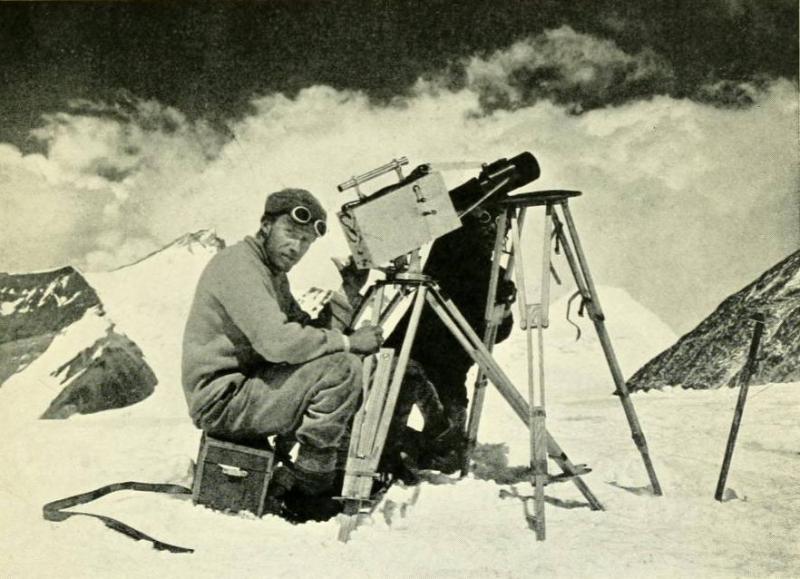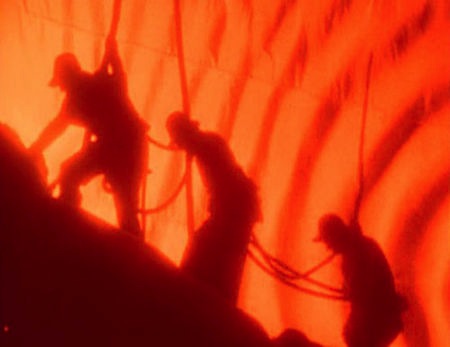Listed: The Best Mountain Movies | reviews, news & interviews
Listed: The Best Mountain Movies
Listed: The Best Mountain Movies
As Everest opens, theartsdesk dons crampons to clamber among the cinematic peaks

It has never been easier for cinema to capture the terror and splendour of the mountains. Cameras can do what they never could before, which is why Everest, released this week, gets audiences as close to the roof of the world as any multiplex experience ever will. But mountains are about more than altitude.
The Epic of Everest (1924)
“This isn’t Hollywood,” said Mallory. “Why do we need a filmmaker?” John Noel was the first great filmmaker of the Himalayas. His bewitching images of Everest, filmed on equipment lugged by sherpas and cleverly customised to withstand the elements, were the only successful product of this tragic 1922 expedition. He pointed his lens two miles across the gaping void of the North Col to capture the last images of Mallory and Irvine alive, and the dismal shot of their deaths being semaphored. Jasper Rees
The Blue Light (1932)
Leni Riefenstahl's films are coloured by the knowledge that Adolf Hitler commissioned her to mastermind – direct, edit, produce and co-write – the 1935 Nazi-glorifying epic Triumph of the Will. She had filmed Hitler in 1933 and, earlier, had seen him speak. The first film she directed was The Blue Light (Das Blaue Licht), an entry in the “mountain film” genre – she had first acted in such for 1926’s The Holy Mountain. Plots pitted man against mountain and, once the peak was conquered, enlightenment and fulfilment was the result. The Blue Light added a twist: Riefenstahl herself played an apparent witch who drove the men of her village to their deaths as they climbed during the full moon. Scaling the mountain herself, she found sanctuary in a hidden grotto illuminated by mystical blue crystals. The film culminates with the villagers violating the refuge. Hitler was certainly aware of The Blue Light, and it was integral to Riefenstahl’s entry to his inner cabal. An arresting film, but one to treat cautiously. Kieron Tyler
The Sound of Music (1965)
Irresistible: The Sound of Music as ur-text for those who aspire vertically. From Julie Andrews singing “I go to the hills when my heart is lonely,” we sweep onwards and upwards towards the heights (vocal, too) of that alpinist classic, “Climb Every Mountain”. Actually it’s sung by the Mother Abbess (Peggy Wood, in her final screen role) in the dark interiors of the convent, the only hint at the great outdoors being the light dawning behind a window. Wood was nominated for Best Supporting Actress, and few realise that she was dubbed for this number by Margery McKay. The follow-up lyric, “Follow every rainbow/’Til you find your dream”, has made the number a classic for gala performances, recently reprised in Lady Gaga’s Oscar mêlée from the film this year. Tom Birchenough
Careful (1992)
 The third film (and first in colour) directed by Guy Maddin, the Winnipeg auteur of silent cinema/early-talkie exhumation and psychosexual lost causes, is a rib-tickling riff on Arnold Fanck and Leni Riefenstahl’s mountain movies (see above) by way of Hamlet, Caspar Friedrich’s paintings, and F.W. Murnau’s Nosferatu. It’s set in an Alpine community terrified that a loud noise or an extreme emotion will cause a devastating avalanche – all too likely given there’s an epidemic of barely repressed incestuous lust. Shot on thrift-shop sets draped in tinsel, webs, and gauze, Careful dazzles with a gorgeous alpenglow, its encoded amber (pictured above), turquoise, pink, green, lilac, rust, and yellow tints perfectly complementing the honed archaism of the crackly soundtrack. Graham Fuller
The third film (and first in colour) directed by Guy Maddin, the Winnipeg auteur of silent cinema/early-talkie exhumation and psychosexual lost causes, is a rib-tickling riff on Arnold Fanck and Leni Riefenstahl’s mountain movies (see above) by way of Hamlet, Caspar Friedrich’s paintings, and F.W. Murnau’s Nosferatu. It’s set in an Alpine community terrified that a loud noise or an extreme emotion will cause a devastating avalanche – all too likely given there’s an epidemic of barely repressed incestuous lust. Shot on thrift-shop sets draped in tinsel, webs, and gauze, Careful dazzles with a gorgeous alpenglow, its encoded amber (pictured above), turquoise, pink, green, lilac, rust, and yellow tints perfectly complementing the honed archaism of the crackly soundtrack. Graham Fuller
Alive (1993)
This gripping survival adventure is based on Piers Paul Read's excellent book Alive: The Story of the Andes Survivors, about the 1972 air crash involving members of a Uruguayan Catholic old boys' rugby team. With a cast led by a young Ethan Hawke, director Frank Marshall overlaid the already gruesome tale - including the survivors eating the flesh of their dead friends - with nods to heroism and faith, much helped by John Patrick Shanley's often allegorical script. Veronica Lee
The Englishman Who Went Up a Hill but Came Down a Mountain (1995)
Is this a mountain movie? It certainly is in Wales, where a mynydd doesn’t have to reach the official height of 1000 feet. Hugh Grant’s posh junior cartographer crosses the border into mid-Wales to measure up a peak, only to announce that it doesn't meet the altitude required. The resourceful locals add earth so it can make the grade, while Grant falls for a lovely lass played with a wobbly accent by Tara Fitzgerald. Based on a Valleys legend heard and massaged by writer/director Christopher Monger, it's charming. No danger of vertigo. Jasper Rees
Touching the Void (2003)
This documentary retold the story of Joe Simpson's extraordinary escape from certain death in the Andes, as first narrated in his best-selling book about a 1985 expedition. Simpson broke his leg and his climbing partner Simon Yates chose to cut the rope from which Simpson dangled over a ledge in order to save himself. Both look haunted by the story 18 years on. The dramatised re-enactments don't quite do the trick but, filletted down, the 25 hours of interviews Simpson gave to director Kevin Macdonald do. There's a cameo on the soundtrack for Boney M's "Brown Girl in the Ring", which chimed in Simpson's hallucinating brain as he slid and scrambled back to life. Jasper Rees
Brokeback Mountain (2005)
Annie Proulx's short story - first published in The New Yorker in 1997 - became a lauded Ang Lee film eight years later that was era-defining in its frank depiction of homosexuality set not among a community of urban sophisticates but in the wilds of Wyoming (hence the title, its phallic implications intact). Charting the unfolding relationship between ranch hand Ennis (Heath Ledger in a performance that should have won him an Oscar before the one that posthumously did) and rodeo cowboy Jack (Jake Gyllenhaal), the film suggested its rural environs as an unexpected source of liberation - which is to say that society may pass judgement but nature tends not to. Matt Wolf
North Face (2008)
Much more thrilling than Clint Eastwood’s earlier visit to the same mountain in The Eiger Sanction, Philipp Stölzl’s powerful film captured the race to get up the Eiger’s forbidding wall in 1935 when conquering Alpine peaks became a propaganda tool for the Nazis. If the politics felt a little crude, and the love story underwhelmed, the climbing footage, in which four mountaineers fight for their lives against cold and gravity, is simply astonishing. Based on the true story originally told by Heinrich Harrer in his mountain literature classic The White Spider. Harrer was in the four-man team which in 1938 made the first successful ascent. Jasper Rees
The future of Arts Journalism
You can stop theartsdesk.com closing!
We urgently need financing to survive. Our fundraising drive has thus far raised £49,000 but we need to reach £100,000 or we will be forced to close. Please contribute here: https://gofund.me/c3f6033d
And if you can forward this information to anyone who might assist, we’d be grateful.

Subscribe to theartsdesk.com
Thank you for continuing to read our work on theartsdesk.com. For unlimited access to every article in its entirety, including our archive of more than 15,000 pieces, we're asking for £5 per month or £40 per year. We feel it's a very good deal, and hope you do too.
To take a subscription now simply click here.
And if you're looking for that extra gift for a friend or family member, why not treat them to a theartsdesk.com gift subscription?
more Film
 Bugonia review - Yorgos Lanthimos on aliens, bees and conspiracy theories
Emma Stone and Jesse Plemons excel in a marvellously deranged black comedy
Bugonia review - Yorgos Lanthimos on aliens, bees and conspiracy theories
Emma Stone and Jesse Plemons excel in a marvellously deranged black comedy
 theartsdesk Q&A: director Kelly Reichardt on 'The Mastermind' and reliving the 1970s
The independent filmmaker discusses her intimate heist movie
theartsdesk Q&A: director Kelly Reichardt on 'The Mastermind' and reliving the 1970s
The independent filmmaker discusses her intimate heist movie
 Blu-ray: Wendy and Lucy
Down-and-out in rural Oregon: Kelly Reichardt's third feature packs a huge punch
Blu-ray: Wendy and Lucy
Down-and-out in rural Oregon: Kelly Reichardt's third feature packs a huge punch
 The Mastermind review - another slim but nourishing slice of Americana from Kelly Reichardt
Josh O'Connor is perfect casting as a cocky middle-class American adrift in the 1970s
The Mastermind review - another slim but nourishing slice of Americana from Kelly Reichardt
Josh O'Connor is perfect casting as a cocky middle-class American adrift in the 1970s
 Springsteen: Deliver Me From Nowhere review - the story of the Boss who isn't boss of his own head
A brooding trip on the Bruce Springsteen highway of hard knocks
Springsteen: Deliver Me From Nowhere review - the story of the Boss who isn't boss of his own head
A brooding trip on the Bruce Springsteen highway of hard knocks
 The Perfect Neighbor, Netflix review - Florida found-footage documentary is a harrowing watch
Sundance winner chronicles a death that should have been prevented
The Perfect Neighbor, Netflix review - Florida found-footage documentary is a harrowing watch
Sundance winner chronicles a death that should have been prevented
 Blu-ray: Le Quai des Brumes
Love twinkles in the gloom of Marcel Carné’s fogbound French poetic realist classic
Blu-ray: Le Quai des Brumes
Love twinkles in the gloom of Marcel Carné’s fogbound French poetic realist classic
 Frankenstein review - the Prometheus of the charnel house
Guillermo del Toro is fitfully inspired, but often lost in long-held ambitions
Frankenstein review - the Prometheus of the charnel house
Guillermo del Toro is fitfully inspired, but often lost in long-held ambitions
 London Film Festival 2025 - a Korean masterclass in black comedy and a Camus classic effectively realised
New films from Park Chan-wook, Gianfranco Rosi, François Ozon, Ildikó Enyedi and more
London Film Festival 2025 - a Korean masterclass in black comedy and a Camus classic effectively realised
New films from Park Chan-wook, Gianfranco Rosi, François Ozon, Ildikó Enyedi and more
 After the Hunt review - muddled #MeToo provocation
Julia Roberts excels despite misfiring drama
After the Hunt review - muddled #MeToo provocation
Julia Roberts excels despite misfiring drama
 Ballad of a Small Player review - Colin Farrell's all in as a gambler down on his luck
Conclave director Edward Berger swaps the Vatican for Asia's sin city
Ballad of a Small Player review - Colin Farrell's all in as a gambler down on his luck
Conclave director Edward Berger swaps the Vatican for Asia's sin city
 London Film Festival 2025 - Bradley Cooper channels John Bishop, the Boss goes to Nebraska, and a French pandemic
... not to mention Kristen Stewart's directing debut and a punchy prison drama
London Film Festival 2025 - Bradley Cooper channels John Bishop, the Boss goes to Nebraska, and a French pandemic
... not to mention Kristen Stewart's directing debut and a punchy prison drama

Add comment